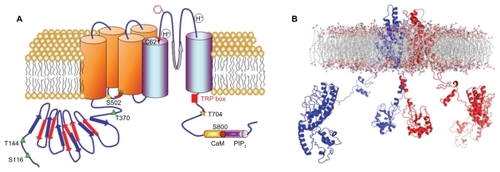Figures & data
Figure 1 A) Putative membrane topology of a transient receptor potential vanilloid 1 subunit displaying the location of residues involved in ligand-binding, proton activation, and post-translational modifications. The transient receptor potential vanilloid 1 domain, and calmodulin- and phosphatidylinositol-4,5-bisphosphate-binding domains are also depicted. B) Side view of the ribbon structural model of two opposite monomers of the transient receptor potential vanilloid 1 channel inserted into the lipid bilayer, after molecular dynamic simulation. The other two monomers are not shown for clarity.

Figure 2 Regulation of transient receptor potential vanilloid 1 function and expression by proinflammatory mediators. A) Acute post-translation modification of transient receptor potential vanilloid 1 function. Activation of phospholipase C/protein kinase C, protein kinase A, calmodulin-dependent protein kinase, and other intracellular signaling cascades increase transient receptor potential vanilloid 1 activity and cytosolic Ca2+ levels. B) Increase of transient receptor potential vanilloid 1 expression by proinflammatory agents. Rapid receptor translocation to the cell surface from the vesicular reservoir (left side). Long-term upregulation of protein levels by transcription/translation process (right side).
